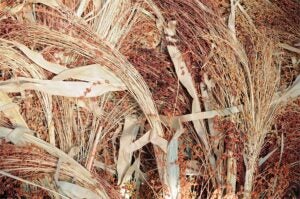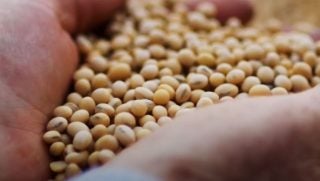No matter whether you’re involved in agriculture or not, you likely have some familiarity with corn. There’s field corn — the type of corn seen the most — which is used most often for animal feed, raw materials, processed foods, sweeteners, and ethanol production, among other things. Sweet corn is the delicious, bright yellow corn eaten off the cob during summer and frozen or canned for winter. Popcorn is another favorite of many people. Movie night certainly isn’t complete without the delicious snack from this crop!
But there are a couple other items under the name “corn” that you might not be so acquainted with — and maybe haven’t even seen before.
These types of corn can often be used in fall in wreaths, floral arrangements, and other festive decorations. One is called broom corn, while the other is ornamental corn, which can also be called Indian corn or Flint corn. Both of these crops are used for decorations, but have many other practical uses as well!
First, let me be straight with you: Broom corn isn’t really corn, but is instead a type of sorghum. It has coarse, fibrous seed heads that are often used today as beautiful fall decorations. For hundreds of years, broom corn has been used to make brooms and other brushes. Broom-making is an art that has been practiced for hundreds of years but has become less and less common today now that most brooms are made of synthetic materials. It takes around 50 broom corn plants to make just one broom.

To make a broom, the fibrous seed heads from this crop are individually attached to a wooden handle. Broom corn was first used for broom production in the late 18th century. Today, most broom corn is grown and turned into brooms in Mexico, but there are still some broom hobbyists in the U.S. practicing the craft today.
Ornamental corn goes by many names and has many uses, as mentioned above. It comes in a variety of colors and sizes. Oftentimes ornamental corn is dried and used for decorative purposes. Some types are long like most corn we’re used to, while other varieties are much smaller at just two to four inches long. Ornamental corn can come in various colors. Some ears of corn are solid colors that come in white, red, blue, yellow, gold, burgundy and even black. However, most ears appear as a multicolored calico of white, blue, red, yellow, orange, pink, burgundy and more. Some kernels can even be variegated, which means that they can be striped with various colors.
Certain varieties of ornamental corn serve important purposes. Some varieties can be ground and turned into flour or cornmeal, while others make for colorful popcorn kernels (unfortunately it all looks white once it’s popped). Many other varieties serve ornamental purposes due to the color of the kernels and the husks. The husks can often be purple or red colored and make for beautiful wreaths, hanging bunches, and even be used in floral arrangements.

Both broom corn and ornamental corn can be grown across the United States. You won’t find much large-scale production, but some smaller scale producers grow these two crops for personal use or to sell as decorations.
These unique crops have been used for hundreds of years for many purposes, but today you’re most likely to see them in fall as seasonal holiday decorations — like Thanksgiving. If you’re looking for something fun to try this fall, make some beautiful decorations out of broom corn or ornamental corn, or to take it one step further, try growing one of these crops next year!
Michelle Miller, the “Farm Babe,” is an internationally recognized keynote speaker, writer, and social media influencer and travels full time to advocate for agriculture. She comes from an Iowa-based row crop and livestock farming background and now resides on a timber farm in North Central Florida.


